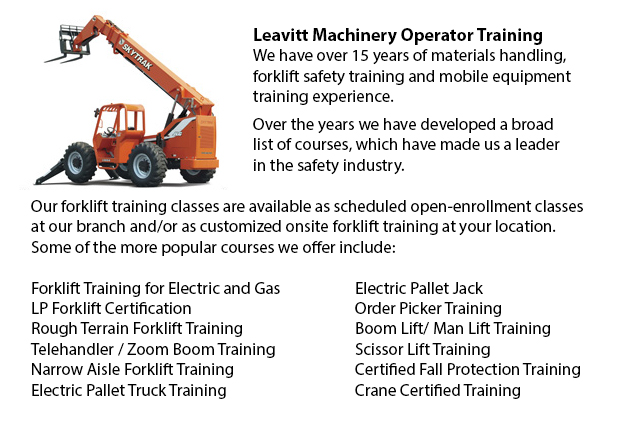
Vernon Zoom Boom Training - Zoom Boom Training focuses on properly training potential operators on variable reach forklifts. The training objectives consist of gaining the understanding of the machine's physics and to define the job of the operator. This program follows North American safety standards for lift trucks. Zoom boom training and certification is available at the company's location or at our site, provided there are a few trainees. Certification received upon successful completion is good for three years.
The telehandler or also known as a telescopic handler is similar in numerous ways to a common forklift or a crane. This helpful machinery is made along with a telescopic boom which could extend forward and lift upwards. A variety of attachments can be connected on the end of the boom, such as bucket, pallet forks, lift table or muck grab. It is popular in agriculture and industry settings.
The telehandler is a common used along with fork attachments in order to enable the shuttling of loads. Telehandlers have the advantage of being able to reach those inaccessible places that cannot be reached by a standard forklift. Telehandlers are capable of removing palletized loads from inside a trailer and placing them on high places like for example rooftops. For some applications, they can be more efficient and practical than a crane.
When lifting heavy loads, the telehandler can experience some instability. As the boom is extended very far with a load, the equipment would become more unsteady. Counterweights in the rear help, but do not solve the problem. The lifting capacity rapidly decreases as the working radius increases. Some machines come along with front outriggers that extend the lifting capacity when the equipment is stationary.
In order to determine whether a load is extremely heavy, the operator could check with the load chart. The factors covered in the calculation includes load weight, boom angle and height are calculated. Various telehandlers have sensors that provide a warning or cut off further control if the unit is in danger of destabilizing.
-
Vernon Heavy Equipment Training Programs
Vernon Heavy Equipment Training Programs - At whatever given construction site, there are often different types of machinery which are ready to be used. These heavy and light machines need both operators to run them and mechanics to fix them. Trainee... More -
Vernon Forklift Safety Training
Vernon Forklift Safety Training - People wanting work in industries that operate lift trucks should undergo a forklift safety training program before becoming a certified operator of a lift truck. There are a lot of ways to go about acquiring forklif... More -
Vernon Aerial Boom Lift Ticket
Vernon Aerial Boom Lift Ticket - Aerial platform lifts can accommodate various odd jobs involving high and tough reaching places. Normally used to complete regular preservation in structures with tall ceilings, prune tree branches, elevate heavy shel... More -
Vernon Manlift Safety Training
Vernon Manlift Safety Training - Manlift operators need to be cognizant and aware of all the potential dangers which are associated with particular classes of scissor lifts. They need to be able to operate the scissor lift in a way that protects not... More -
Vernon Forklift License
Vernon Forklift License - Obtaining a forklift certification or forklift license in North America will require the one training to carry out hands-on training in addition to classroom instruction. The provincial, federal and state regulatory bodies a... More -
Narrow Aisle Forklift, Order Picker, Electric Pallet Jack, Electric Pallet Truck Certification in Vernon
A pallet lift is a model of equipment dedicated in the transporting of pallets of many dimensions and weights. They can be utilized as an appendage for forklifts, cranes and other styles of heavy machinery or be applied on their own. Pallet hoists ar... More -
Vernon Boom Lift Safety Training
Vernon Boom Lift Safey Training - Boom lifts are a type of elevated work platform or aerial lifting device which are commonly utilized in construction, industry, and warehousing. Boom lifts can be utilized in practically any surroundings because of t... More -
Vernon Manlift Operator Training
Vernon Manlift Operator Training - The aerial lift or manlift is a specialized kind of hydraulic platform that is designed to lift a person vertically giving it an alternate name of a vertical personnel lift. These machinery are widely utilized for a... More

Forklift Certification Vernon
TOLL FREE: 1-888-254-6157
Vernon, British Columbia
forkliftcertificationvernon.com
Email Us
About Us


